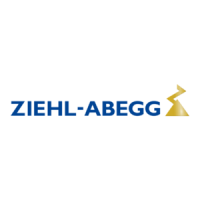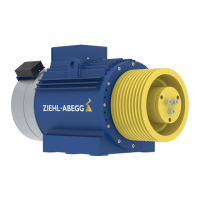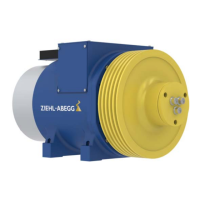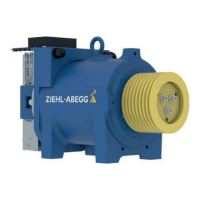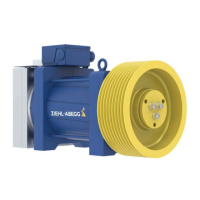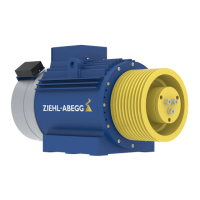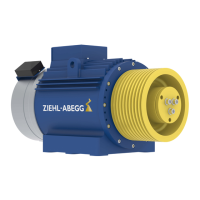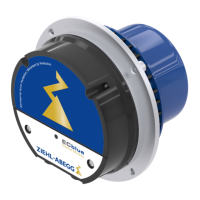2. Failure of one brake circuit:
The test shall be carried out whilst the car is descending at rated speed with rated load.
To simulate failure of a brake circuit, it must be possible to keep the brake circuits open mechan-
ically independently of one another even when opening the safety circuit.
This condition may not be permanent and must therefore be created using buttons or similar.
At the same time, the safety circuit should be opened when using this function.
For this test, the elevator must be observed.
If no discernible delay occurs, the brake circuit held open is to be closed immediately.
The system should be stopped and the brake tested.
As an example, refer to the principle circuit diagram in the “Electrical installation / Brake / Brake
control” chapter. The logic of the principle circuit diagram should be understood. Transferability to the
relevant application must be verified and ZIEHL-ABEGG SE provides no guarantee of suitability.
If the circuit is designed in accordance with the principle circuit diagram:
At the nominal speed, press one of the buttons and hold it down until the elevator has stopped.
Repeat the test with the other button to test the second brake circuit.
3. Testing the microswitches / inductive proximity switches
The release monitoring for the brakes must be evaluated.
Before every trip, the change in the state of both brake circuits must be monitored separately.
Switching must thus be tested individually, according to the function as an NC and/or NO contact.
If there is a missing or incorrect signal, the elevator cabin may not leave the stopping point.
6.4 Pull out of safety gear
If the cabin loaded with rated load is caught by the trap due to a failure or during the acceptance
inspection, the capture device could be very tight. In this case it is quite possible that the elevator
machine torque is insufficient to pull the cabin out of the trap.
With gearless elevator machines in the shaft, the elevator machine is usually not accessible. A
handwheel is unnecessary in such a layout.
With gearless elevator machines in machine rooms, a handwheel does not make any sense because
there is no gear reduction. That is because due to the low moment arm of force, only slight force can
be applied. A handwheel could even present a hazard, as even with only a slight imbalance in the
installation, it is no longer possible to stop the elevator with the handwheel.
For both cases involving gearless elevator machines:
If the elevator machine torque or the traction conditions are not sufficient, a block and tackle or
similar device should be used.
Suitable block and tackle should be provided.
Note
Note that an overload in the car leads to an increase in the motor torque. 25 % overload results in
150 % of the required motor torque! As regulated elevator machines are normally designed for a
maximum torque of ca. 170 - 200 % rated torque, only slight reserves are available during such
special cases.
Correspondingly, section 6.3.4 "Capture device on the cabin" in EN 81-20:2020 must be followed:
“In order to facilitate disengagement of the safety gear, it is recommended that the test be carried out
opposite a door in order to be able to unload the car.”
6.5 Emergency evacuation
Attention!
The measures for emergency evacuation described below may only be performed by instructed
persons for maintenance of the elevator or qualified personnel of elevator companies.
6.5.1 Emergency evacuation by release of the brakes
In case of power failure or failure of the recovery control, emergency rescue is only possible by
releasing the brakes. The brake can be released by an electrical emergency power supply or, if
available, by a manual hand release.
When the brakes are released manually, the elevator moves in the direction of the greater weight. If
there is a balance between the cabin and the counterweight, the cabin must be made heavier by
suitable means.
Translation of the original operating instructions
ZAtop – model series SM200.40E/SM200.45E Commissioning
A-TBA21_01-GB 2021/30 Index 003 Part.-No. 01013507-GB (EU-BD 1112)
24/64

